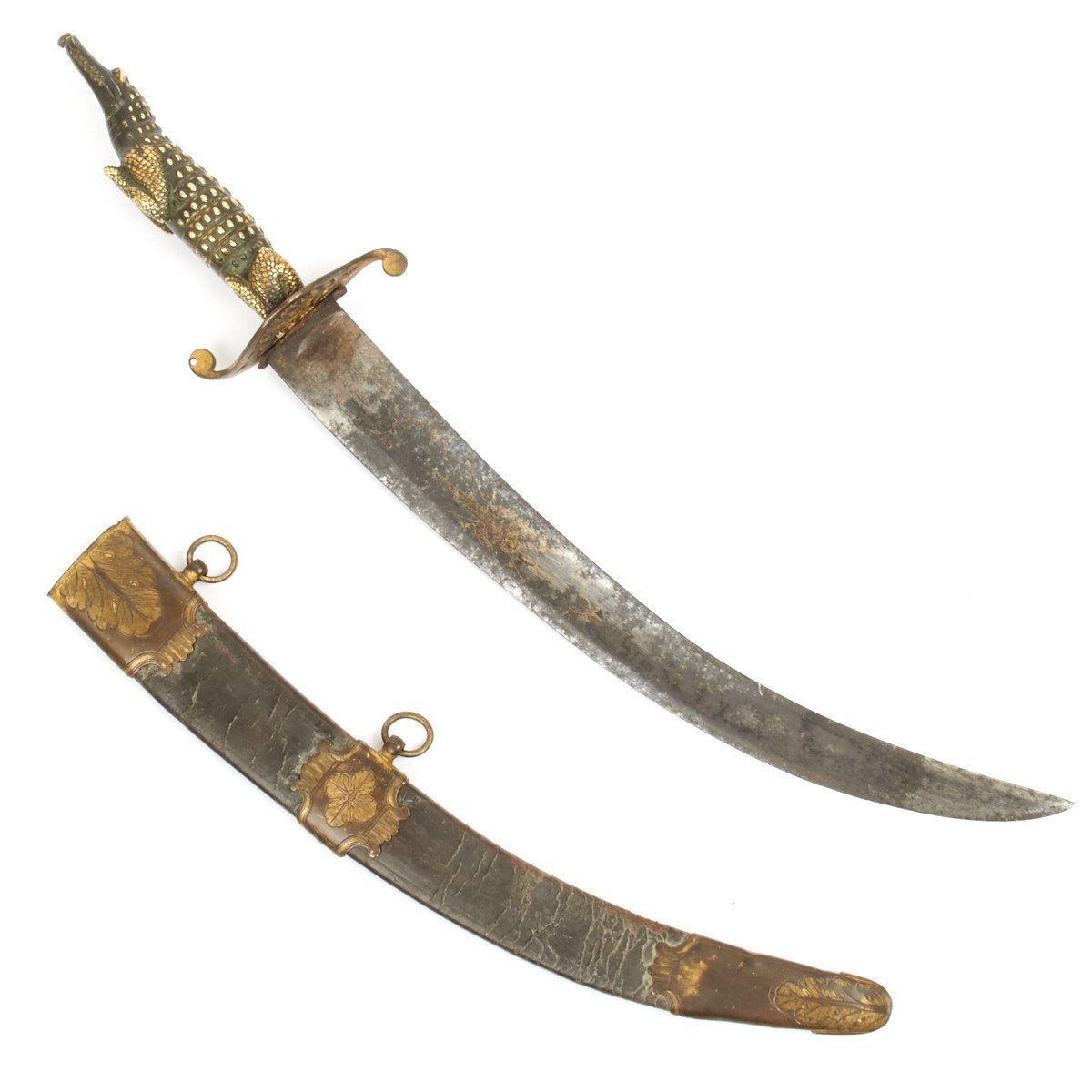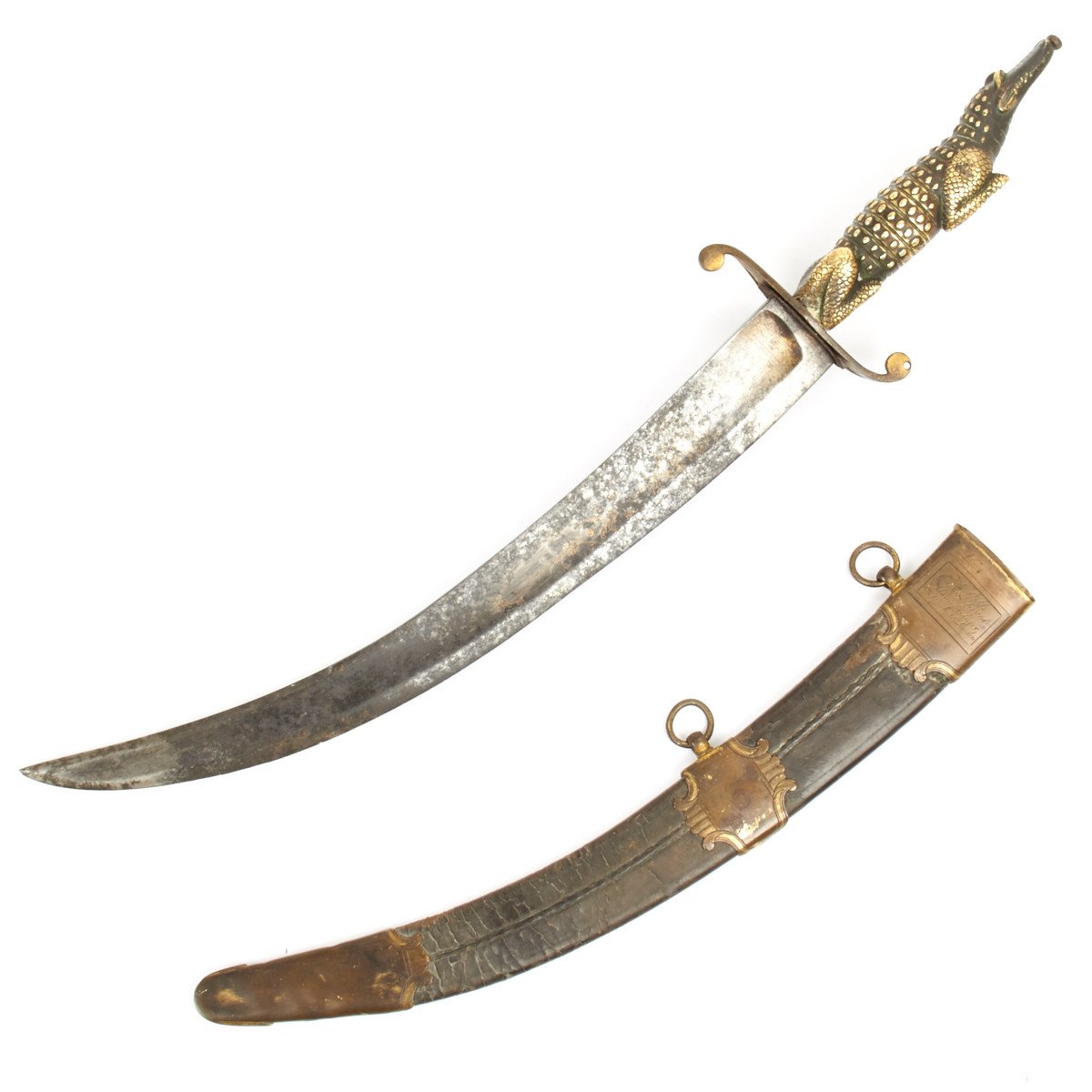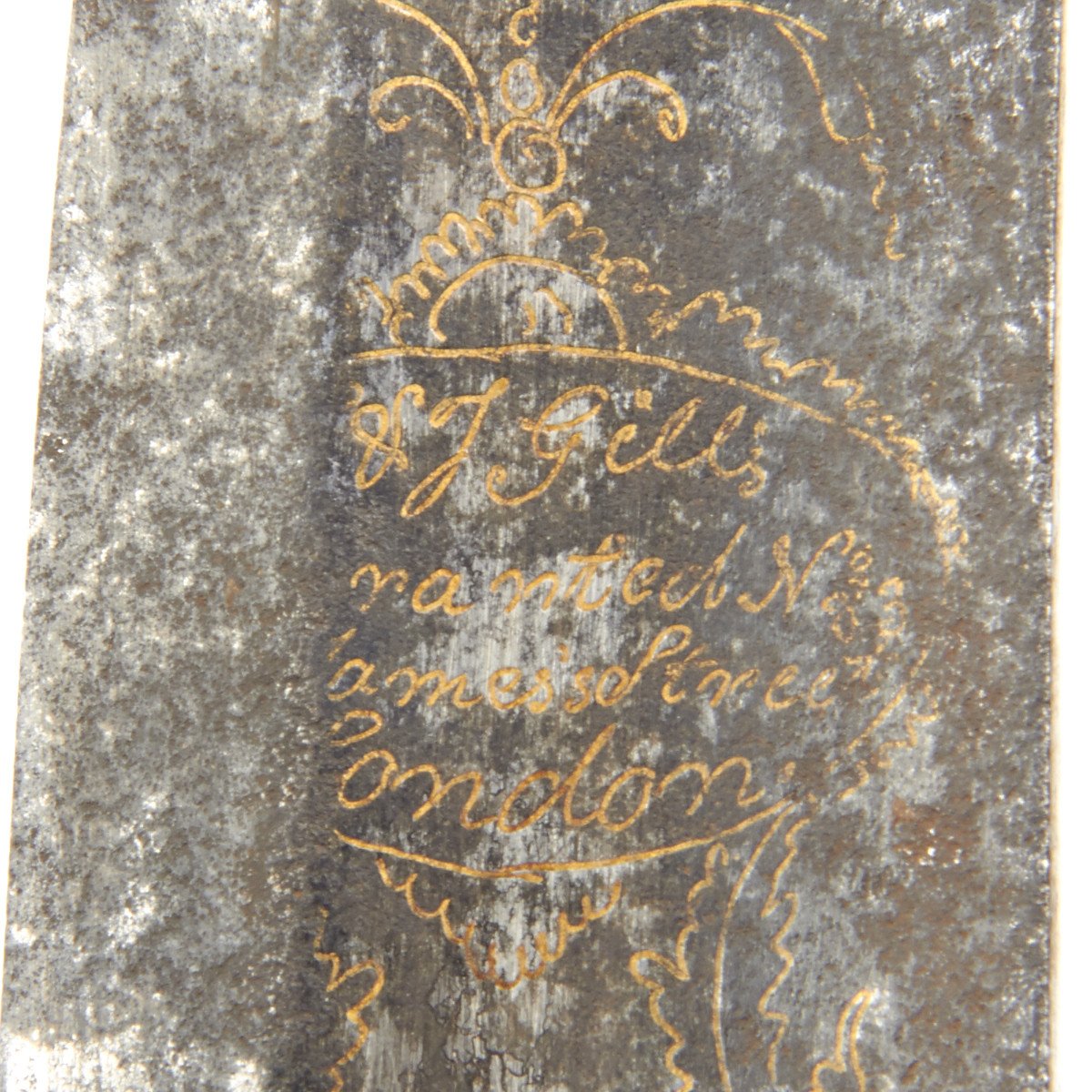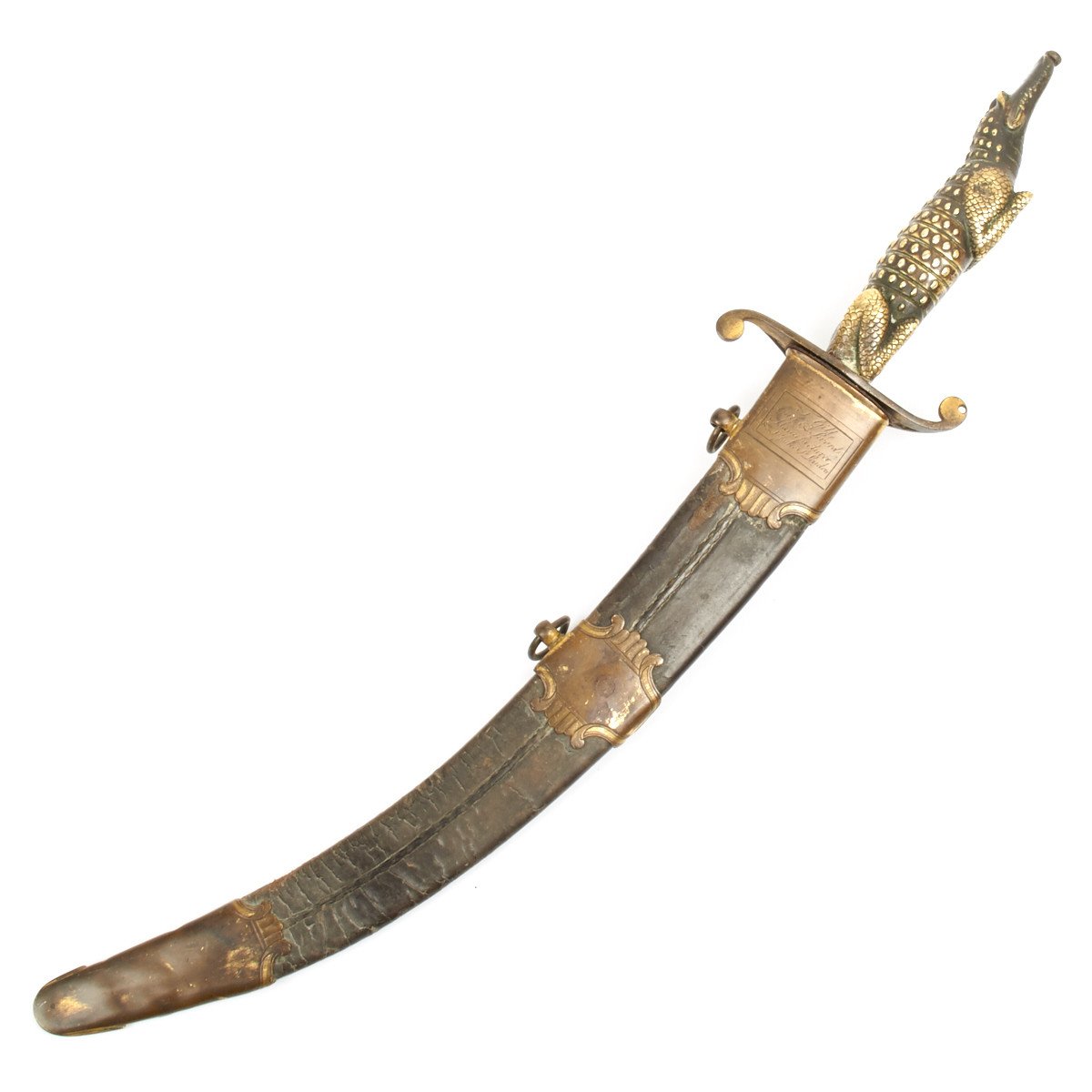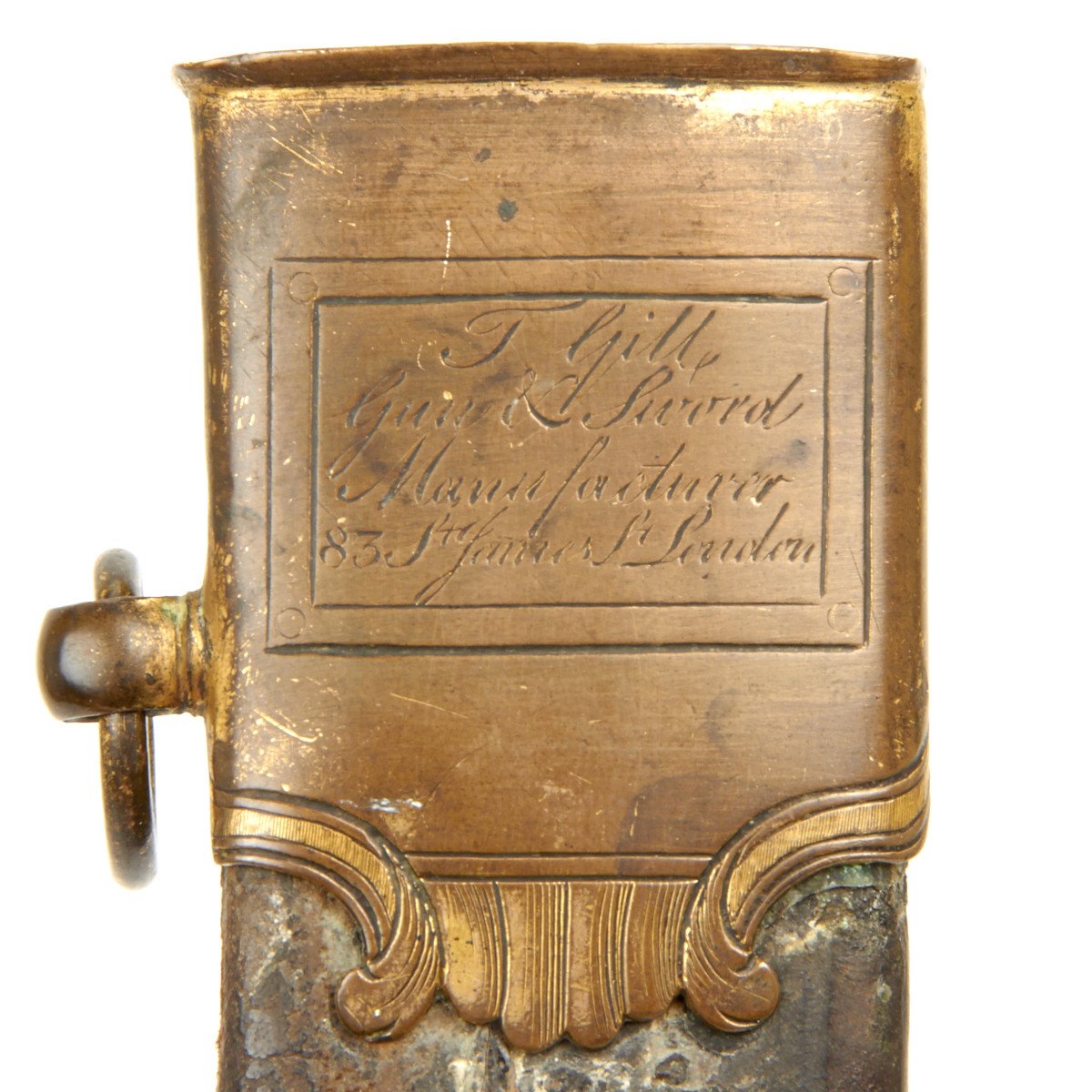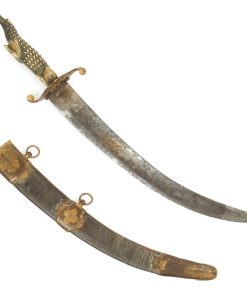Original British Nile Dirk by London Maker Thomas Gill – Circa 1800 Original Items
$ 14.995,00 $ 3.748,75
Original item: Only One Available. These dirks are legendary and exceptionally rare. Private purchase by Naval officers and midshipmen these have the flavor of Nelson’s BATTLE OF THE NILE in 1798.
On a typical Nile Dirk the grip pommel shows the head of a Crocodile but this special unique dirk has an entirely solid brass grip of a complete crocodile.
Significance of the crocodile: After the battle, Nelson’s captains who fought at the Battle of the Nile formed The Egyptian Club to meet and commemorate the battle. They commissioned a limited number of swords and medals for issuance to the victors, all most all of which had an emblematic crocodile as part of the design. Among their first actions were to present a crocodile handle sword to Nelson and commission this portrait. In 2002, at a Sotheby’s Nelson auction, another ceremonial sword with its hilt in the shape of a crocodile was estimated at £40,000 to £60,000, and sold for £270,650 to a private collector. The engraved sword was one of a handful made for the elite Egyptian Club.
The Battle of the Nile in 1798 was the first of Horatio Nelson’s three great victories, followed by the Battle of Copenhagen in 1801 and The Battle of Trafalgar in which Nelson was killed in 1805. The man is a legend and one of England’s favorite sons.
This remarkable example of a Nile Dirk was included in a fabulous British Naval Collection more of which is arriving from England soon. The dirk has a 14″ curved blade and is 20″ in overall length. The blade still retains original engravings and some gold inlay including the maker’s name and address. Complete with the original gilt brass mounted leather scabbard also marked:
T GILL
Gun & Sword
Manufacturer
83 St James St London
Thomas Gill was one of London’s most respected outfitters of the day and worked from 1770 until 1812.
This is a magnificent weapon commemorating Horatio Nelson’s great victory at THE BATTLE OF THE NILE that ended Napoleons ambitions in Egypt.
DIMENSIONS:
Blade: 14″ long x .25″ at widest
Grip: 6″ long x 1.25
Dirk length overall: 20
Length in scabbard: 2.5
Dirks have a long history in the Navy and date as far back as the Barbary War (1805) and were used as part of the midshipman’s uniform as late as 1867. Early dirks are very rare since their were only 550 officers in the Continental Navy.
America’s armed forces were increased in numbers around 1799 with the approach of the War of 1812 with England. It was in those years at the turn of the 19th century swords and dirks were made, mainly in England, in a style that was typically American in character for our military. At the same time, the eagle in its entirety, with or without the motto, “E. Pluribus Unum,” was incorporated in the decoration of blades. After great deliberation and much discussion, the eagle was finally adopted in 1782 as an appropriate national emblem. Shortly thereafter, it made its official début in the use of the Great Seal of the United States, and on the coinage. Soon afterward this insignia made its appearance generally on military paraphernalia. In the United States National Museum at Washington is an unusually interesting officer’s saber with its blade decorated with spread eagle, motto, and the date 1783. This is without question one of the first swords to be so designed and inscribed. In the naval service dirks had a short-lived, probably from about 1805 into the 1840’s except for the midshipman’s version authorized in 1867.
Fast Shipping with Professional Packaging
Thanks to our longstanding association with UPS FedEx DHL, and other major international carriers, we are able to provide a range of shipping options. Our warehouse staff is expertly trained and will wrap your products according to our exact and precise specifications. Prior to shipping, your goods will be thoroughly examined and securely secured. We ship to thousands clients each day across multiple countries. This shows how we're dedicated to be the largest retailer on the internet. Warehouses and distribution centres can be located throughout Europe as well as the USA.
Note: Orders with more than one item will be assigned a processing date depending on the item.
Before shipping before shipping, we'll conduct a thorough inspection of the items you have ordered. Today, the majority of orders will be delivered within 48 hours. The delivery time will be between 3-7 days.
Returns
The stock is dynamic and we cannot completely manage it because multiple stakeholders are involved, including our factory and warehouse. So the actual stock may alter at any time. It's possible that you may not receive your order once the order has been made.
Our policy is valid for a period of 30 days. If you don't receive the product within 30 days, we are not able to issue a refund or an exchange.
You can only return an item if it is unused and in the same state as the day you received it. You must have the item in its original packaging.
Related products
Uncategorized
Uncategorized
Uncategorized
Australian WWII Owen MK1 Machine Carbine SMG Custom Fabricated Replica with Sling Original Items
Uncategorized
Uncategorized
Uncategorized
Uncategorized
Band of Brothers ORIGINAL GERMAN WWII Le. F.H. 18 10.5cm ARTILLERY PIECE Original Items
Uncategorized
Uncategorized
Uncategorized
Uncategorized
Uncategorized
Angolan Rebel 1970s era 60mm Inert Display Mortar from Angolan Civil War Original Items
Uncategorized
Uncategorized
Uncategorized
Uncategorized
Uncategorized
Uncategorized
